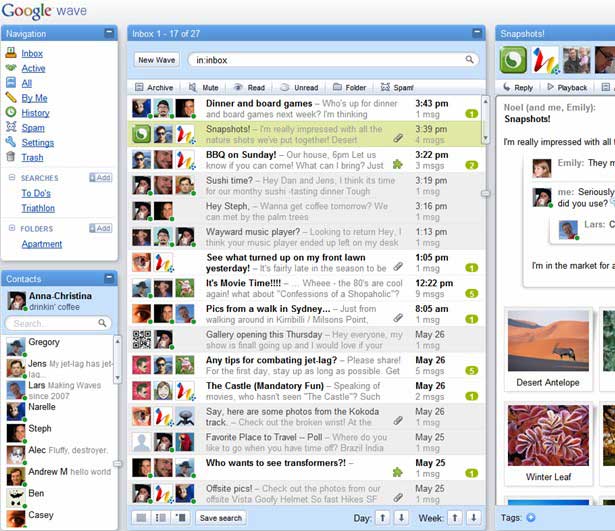Starting today, Google will invite 100,000 users to beta-test its much-buzzed Wave, a communication and collaboration platform combining elements of email, chat, social networking, and wiki. Receiving invitations will be developers, people who did earlier testing, and a few business users of Google Apps, wrote Lars Rasmussen and Stephanie Hannon yesterday in a joint post on Google's site.
Lars Rasmussen and his brother Jen lead the Sydney-based team developing Google Wave, and Stephanie Hannon is Wave product manager. Although no date has been set for its general release, Rasmussen and Hannon write that it will be publicly available "later this year."
Since its unveiling at the Google I/O developer conference in May—see the presentation here—Wave has generated intense interest, writes Miguel Helft in The New York Times' Bits blog. Calling Google Wave "an attempt to re-engineer Internet communication," CNET's Tom Krazit reports that Google has already received requests from more than 1 million people to beta-test it.
The Wave Experience
Wave's aim is to make online communication more richly collaborative, multidimensional, efficient, and instantaneous. In Wave, groups of users share an online desktop on which they "can exchange messages, share and edit documents, drag and drop widgets and play games," writes Helft. Here's a screenshot from the Google Wave site:

Rasmussen and Hannon link to descriptions of projects that early users have accomplished on Wave:
- Journalist Andy Ihnatko on producing his Chicago Sun-Times column.
- Filmmaker Jonathan Poritsky on streamlining the movie-making process.
- Alexander Dreiling and his SAP research team on collaborative business process modelling.
The collaborative aspects of Google Wave extend to developers. Wave is a platform "with a rich set of open APIs that allow developers to embed waves in other web services and to build extensions that work inside waves." Hannon, in a separate blog post yesterday, said that "to help foster a strong developer ecosystem," the company is "exploring plans for a monetizable wave extension store."
Google Wave and Online Marketing
What will all this mean for marketers? No one's sure, but Wave's impact could substantially alter the online marketing landscape. Here are two quick takes on how that changed landscape might prove hospitable to marketers:
Dan Shust writes on the Ad Age website that "Wave opens up myriad opportunities for brands":
Say, for example, a marketer wanted to create a Wave to solicit user generated content— photos/videos of a certain product in action, testimonials, ratings, etc. The architecture of a Wave makes it very easy for the user to drag and drop media and converse in the Wave. The brand can easily repurpose the content automatically, in real time, in blogs, destination websites, mobile/location based applications, etc. The history of the Wave is always available so the user can go back in time to see how the content and conversations develop.
"Kerry" (a nom de Web), blogging for the UK-based High Position, considers how Google Wave might affect SEM:
Using a real-time application [like Wave] means that companies will have a chance to monitor search trends more effectively than ever before. If live correspondence is being held on a central server, it means that companies can target potential clients at the most applicable time. For example, an IM that contains a message from someone saying that they fancy a cola will generate an advert from the highest bidder at the time. Aternatively, a document that is being worked on between colleagues in a wave could attract ads for software that would improve the efficiency of a particular company project.
Wave is going to get bigger before it hits the ground. Get ready.



